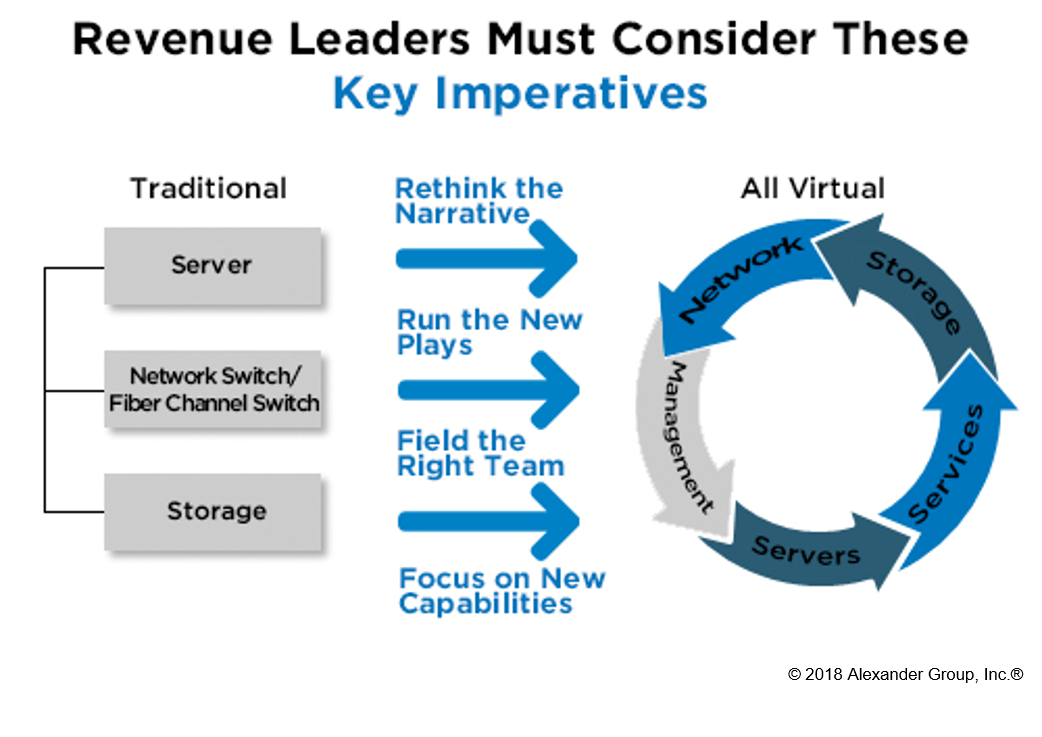Technology Infrastructure Providers: Winning With Hyperconvergence

This blog is written specifically for technology companies that provide core IT infrastructure to businesses, and how the rise of hyperconvergence impacts their sales motions and strategies.
Hyperconvergence—generally speaking, the unification of both on- and off-premise IT infrastructure—is having a significant impact on businesses and customers across the globe. But the question remains: how can infrastructure providers equip themselves for success in this rapidly evolving arena?
The rise of cloud, and technology sold as a service, is creating an indelible transformation to businesses and how they purchase and utilize IT resources. With this, the role of a CTO, CIO or even line of business leader (LOB) has changed. In the past, IT leadership defined, implemented and owned IT infrastructure as a manageable asset. Today these same leaders must oversee strategies for solving business problems with the application of IT resources at all consumption levels (own, rent, as-a-service). This has refocused their time and effort from asset manager roles to strategic technology business advisors.
As such, infrastructure providers must rethink their go-to-customer models with specific focus to enhance and expand the relationship between themselves and their customers. With a fully equipped, highly immersed sales force, infrastructure providers can clear a path for their customers to implement a resilient, scalable hyperconvergence strategy.
What does a successful infrastructure provider strategy look like? Customer roadblocks foreseen and addressed in advance. Desired business outcomes, clearly defined and articulated to sales forces. Customer needs and expectations, met and even surpassed.
Hyperconvergence, in its combining of private cloud, partner cloud and terrestrial IT architecture, can go a long way in helping customers embark on a journey that is unfettered, expansive and ultimately, capable of sustaining business outcomes with a broad, deep scope. Infrastructure companies must help their customers in this pursuit. Let the journey begin.
Hyperconvergence Is Your Ally
Imagine a scenario in which your customer—perhaps a large multinational corporation—is searching the IT landscape for an organization that can provide long-term infrastructure resources, including cloud and virtual assets; licensing; on-premise hardware; and adroit, responsive security. In a legacy world, your seller called on the CIO with an offer of superior functionality and low cost of ownership. Today’s buyer could just as easily reside in the line of business, finance or other functional area. Today’s buyer demands business outcomes and seamless integration of a wide portfolio of assets within your company, your partners and potentially your competitors.
And this is where hyperconvergence can become an ally, rather than a hindrance. With the right implementation of a hyperconverged environment, a once complex, time-consuming series of negotiations between multiple providers can rapidly become a cohesive strategy that pays dividends in short order. In fact, with an approach that favors results above all else, hyperconvergence implementation can become a win-win-win for your company, your customer and your partners.
It’s no longer enough for your sales team to merely talk products. They need to understand how your customers use your products to drive business outcomes. It’s no longer enough to understand how your products work in isolation. Your sales team needs to be able to talk about an integrated solution of your products, your partners’ products and other components of the customer’s IT portfolio. This overall understanding of the entire ecosystem represents a sea change in the messaging approach to solutions and services.
Four Key Imperatives
 Success in a hyperconverged world requires a recalibration of your go-to-customer model. What does this recalibration look like? Here are four key imperatives that have emerged across multiple success stories:
Success in a hyperconverged world requires a recalibration of your go-to-customer model. What does this recalibration look like? Here are four key imperatives that have emerged across multiple success stories:
- Rethink the narrative
- Run the new plays
- Field the right team
- Focus on new capabilities
Rethink the narrative. A focus on outcomes, new buyers and the changing role of partners requires a new story. Messaging and value propositions must clearly describe how your solution fits within the broader ecosystem, what results the solution will deliver for different stakeholders, and what differentiates your solution in a world of ever-improving features and functions. Marketing and sales must work together to build fact-based messages that will resonate with buyers.
Run the new plays. Underpinning the hyperconverged world is a set of new plays and a more sophisticated view of client account management. Multiple sets of buyers from CIO, to line of business leader to CFO are weighing in on IT decisions that in the past remained in the realm of the IT organization. Accompanying this shift is a new set of marketing, sales and service motions that must be defined and deployed by an agile set of players, all done in the right order and coordinated fashion.
Field the right team. Delivering a fresh, compelling narrative through a new set of motions has significant implications for the coverage model and team roles. Singular generalists are no longer enough to thoroughly engage with buyers. Every customer-facing role on your team should understand the new narrative in order to meaningfully communicate with a range of buyers, including IT leaders, LOB operators and CIOs.
Focus on new capabilities. It’s up to your team to know your customers’ and partners’ (service providers and outsourcers) businesses as well as—if not better than—they know themselves. The skill set of the seller revolves around a thorough knowledge of the customer’s and partner’s IT infrastructure, a deep familiarity of vendor relationships and a proclivity for selling to desired business outcomes.
Converging on Hyperconvergence
In an outcome-centric, hyperconverged IT environment, infrastructure providers can work in partnership with their customers to add resources, scale systems, improve security and enhance performance in ways that are the most meaningful and relevant to the customer’s business.
Infrastructure providers that are succeeding in this new world are empowering sales teams, improving operational efficiencies and exceeding the expectations of smart and demanding customers—all while minimizing costs and improving the bottom line.
Alexander Group project work and research suggests that there are important lessons to be learned from these success stories. It’s worth examining how hyperconvergence has had an impact on customers’ businesses, their customer relationships and their opportunities for growth.
It’s a discussion well worth having.
For more on succeeding in today’s hyperconverged environment, please visit our Technology Practice page to learn about our revenue growth methodology and how we can evaluate your go-to-customer model.